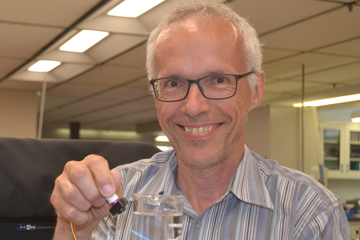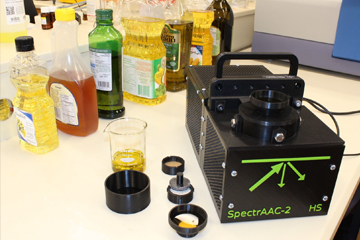Set up an interview
Media Relations
Agriculture and Agri-Food Canada
1-866-345-7972
aafc.mediarelations-relationsmedias.aac@agr.gc.ca
In the food sector, processing companies and regulatory bodies must use control mechanisms to verify the quality or authenticity of food. There are significant costs associated with this, as long and complicated laboratory analysis methods are often required.
An invention from Agriculture and Agri-Food Canada (AAFC) research is about to change the game. Alain Clément and Bernard Panneton, research scientists at the Saint-Hyacinthe and Saint-Jean-sur-Richelieu research and development centres (RDCs), have developed a device capable of measuring the optical fingerprint of liquid and solid foods to verify their quality or authenticity, without having to destroy the foods being tested.
SpectrAAC-2 is a small, inexpensive spectroscopy module that can indicate within minutes whether a food has an abnormality, a flavour defect or an adulteration due to the addition of an ingredient.
In this video, Alain Clément gives an overview of how it works:
Video: SPECTRAAC-2
Video Transcript
The SPECTRAAC-2 is a device for taking food quality measurements.
The food is stimulated so that it emits light by itself.
This light is captured, producing what we call spectra.
These spectra are placed into banks that make up our databases.
The main possibilities of this technology are in the measuring of food’s freshness and authenticity.
A wide variety of foods can be measured.
This is characteristic of the method we’re using.
Powders, liquids, syrups, solids, ideally solids that have been ground up or pastes.
Virtually all foods give us a signal.
A device like this costs about 10 thousand dollars to build.
It’s a piece of equipment that we built here in the laboratory, that we assembled entirely in the laboratory.
In addition, many of the parts are 3D printed.
There is practically no sample preparation.
The food can be taken directly, placed on the device and measured.
It’s extremely fast; it runs at an industrial pace.
The next step, I think, is to set up larger databases with manufacturers so that we have a greater capacity for quality control.
Quality and freshness
Some antioxidants in food are highly fluorescent and serve as indicators of freshness. Based on the light spectrum and database of the food being evaluated, SpectrAAC-2 can easily detect any abnormal optical fingerprints, indicating that the product is altered.
“The device captures the natural fluorescence emitted by food that has been subjected to ultraviolet radiation. Its light spectrum is compared with others in a database. SpectrAAC-2 very quickly detects problem foods. They can then be analysed using more conventional methods to find out more about their composition.”
– Alain Clément, Research Scientist, Rapid Characterization of Food, Agriculture and Agri-Food Canada
Thanks to this innovation, food companies will be able to assess the quality of the different batches of food they produce. It could also allow them to detect ingredients that lack freshness. This information is very useful before beginning preparation of sauces, juices or fine bakery products.
A new application of SpectrAAC-2 has just been finalized for olive oils. It can detect whether an oil is rancid in one minute.
Each type of food has its own fluorescence pattern. A food company can quickly create its own database from the optical fingerprint of samples of its products.
For more information on how SpectrAAC-2 can be used for your food products, please do not hesitate to contact Alain Clément by email at alain.clement@agr.gc.ca.
SpectrACER is one of the first inventions of this kind and is widely used in Quebec to evaluate the quality of maple syrup. It is the result of a close collaboration between the Saint-Hyacinthe RDC and the Centre ACER.
Authenticity
SpectrAAC-2 can also quickly detect adulterated foods. Recent research led by the research scientist has proven that optical fingerprinting can be used to differentiate pure ice ciders from related products (still, effervescent or fire ciders).
The fight against food fraud is complex. However, SpectrAAC-2 fluorescence spectroscopy combined with infrared spectroscopy could provide quick and extremely powerful methods for detecting counterfeit foods.
All in all, SpectrAAC-2 has enormous potential to make food control more affordable, fast and easy to implement. In addition, its widespread use could help expand the supply of high-quality food to consumers across the country.
Key Discoveries (Benefits)
- SpectrAAC-2 is a small, inexpensive spectroscopy module that can indicate within minutes whether a food has an abnormality, a flavour defect or an adulteration due to the addition of an ingredient.
- The device captures the natural fluorescence emitted by food that has been subjected to ultraviolet radiation. Its light spectrum is compared with others in a database. SpectrAAC-2 very quickly detects problem foods.
- SpectrAAC-2 can also quickly detect adulterated foods. Recent research has shown that optical fingerprinting can be used to differentiate pure ice ciders from related products (still, effervescent or fire ciders). The device could help detect counterfeit foods.
Photo gallery

